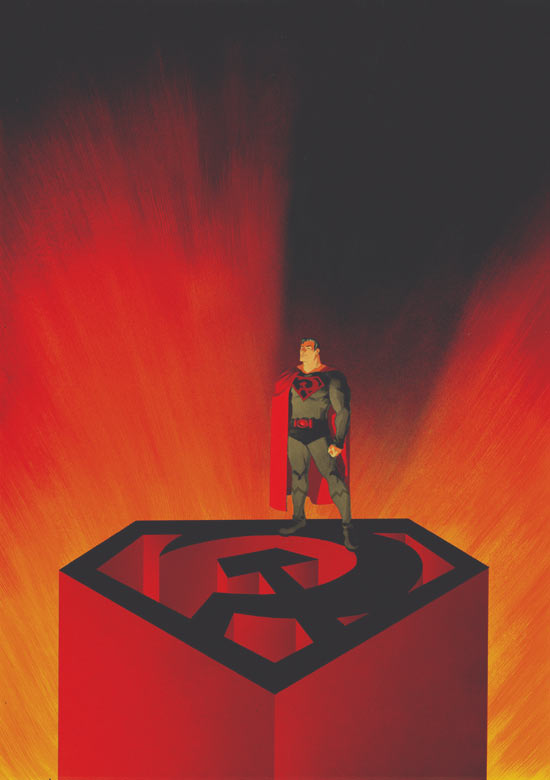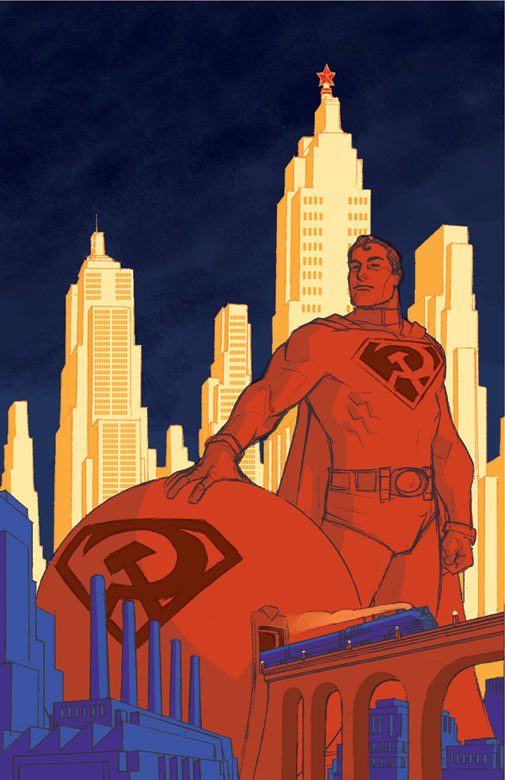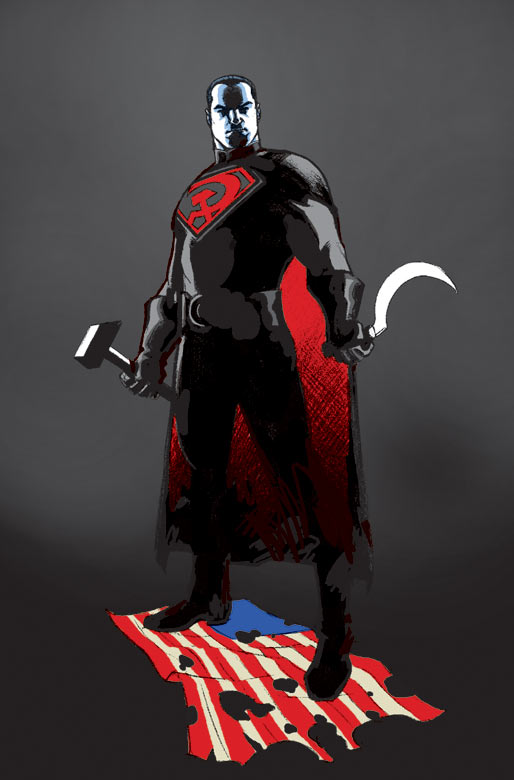|
Ecosse: Cover story: Is it a bird? Is
it a plane? No, it's Superman, but not as we know
him.
Scots cartoonist Mark Millar is risking the wrath
of the US by turning the all-American icon into
a Soviet crusader. Here he explains why :
Superman is as American to me as apple pie and
weapons of mass destruction. Thus, when Superman’s
people called me up and asked me to write his story,
I took great pleasure in turning the concept upside
down and giving the Americans something decidedly
unsettling in these brainwashed, patriotic times.
As a Scotsman I don’t think I’ve really got quite
the same reverence for men in uniform that fly around
and tell people what to do as our American allies
seem to have. Growing up, I always wondered why
a character that could solve the world’s problems
overnight with those preposterous superpowers would
spend so much time chasing bank robbers and mad
scientists when he could at least drop some sandwiches
off to the starving in Africa if he was such a nice
guy. How could a man with super hearing and telescopic
vision ignore what was happening in Iraq, Indonesia,
China and South America? Could Superman really be
described as a hero when all he ever did was reinforce
the world’s unjust status quo?
All these thoughts were bubbling around in my head
when DC Comics in New York approached me and asked
me to do something radical with their Superman concept.
Some years earlier it had achieved great success
by approaching a writer called Frank Miller and
asking him to do something crazy with the Batman
franchise. The result not only reinvigorated the
slightly tired and creaky comicbook industry but
also spawned the multi-billion-dollar Batman movie
franchise and a legion of imitators. Miller gave
them a political Batman with a burning rage against
Ronald Reagan’s America, and produced an award-winning,
four-volume political cartoon that savaged the biggest
figures of the day. It has gone down in pop culture
history as perhaps the greatest comicbook graphic
novel of all time. It also made Miller one of the
richest writers in America and Batman became one
of the most successful movies of all time. The Manhattan
office of DC Comics was deafened with the sound
of rustling dollar bills.
It was with these quite daunting thoughts that I
set out to do the same for Superman. A generation
after the seminal Batman: The Dark Knight Returns,
I’ve given the Americans Superman: Red Son — and,
if you’ll excuse me for a second, I’m just nipping
into my air-raid shelter to prepare for the barrage
of friendly fire that’s sure to hit when Red Son
reaches the shelves next Thursday. It’s not as if
they didn’t know what to expect. I’d made my name
a couple of years ago with a stint on a radical
superhero comic called The Authority, where I wrote
about the world’s first gay comicbook crime fighters
and featured a multicultural superhero team deposing
the corrupt administration in Indonesia. Within
a few issues, we were outselling their more traditional
Superman and Batman titles and before long I was
poached by Marvel Comics to reinvent the X-Men and
reinvigorate some even more famous household names
such as The Hulk and Captain America, whose sales
had languished in the doldrums for more than a couple
of years. What I gave Marvel was a cynical, dark,
hyper-violent X-Men comic and a rejig of all its
other big names in a superhero title less concerned
with super-villains and special effects and more
about domestic abuse, drug addiction and an Incredible
Hulk with a dangerous, uncontrollable libido that
only the American military was capable of stopping.
Under normal circumstances, these very qualifications
would make writing a conservative character such
as Superman for a conservative company such as AOL
Time Warner impossible, but I was lucky in the sense
that both titles launched as the biggest sellers
in the western world for their respective years
and so a certain amount of freedom was given to
this plucky Scotsman. As soon as the cash registers
started ringing, the keys to the family car were
offered, and I was allowed to cut loose and basically
do what I wanted with this treasured icon, completely
unhampered by 60 years of comicbook, movie and television
continuity. As someone who had grown up with this
stuff, I was essentially in heaven.
My first port of call was an idea I came up with
as a small child. I was raised in a very politicised
working-class home in Coatbridge, with more than
its fair share of left-wing literature lying around.
My father was a union guy with a sympathy for communism
and one of the earliest stories I remember writing
to please him was a Soviet superhero thing. America
had Spider-Man, Batman, Superman, The Fantastic
Four, etc. But who did Russia have to patrol the
rooftops? KGB spy satellites? What I created in
the pages of an old school jotter was the Soviet
answer to Superman, his costume based on the flag
of the USSR in much the same way Superman is dressed
in the colours of the stars and stripes. Just as
Superman stood for truth, justice and the American
way, this guy stood for Stalin, international socialism
and the glorious five-year plan. It was obviously
unsophisticated, but there was something so primal
and different about this visual that I look back
on it now as the creation of my first high concept.
Thus, when DC Comics offered me the chance to do
something different with Superman, I dug into my
old files and decided to pitch this as a complete
inversion of everything the world understood about
the character. 
For those of you who grew up wasting your time reading
novels and textbooks instead of trashy, four-colour
comic books, Superman was created in 1938 by a couple
of Jewish teenagers from Ohio in the midst of the
depression. This Moses-like story about the last
survivor of a dying civilisation sent to Earth so
that he might have a decent chance in life had a
particular poignancy for the Jews, and the idea
of a lone immigrant trying to make it in a strange
land also resonated with every culture in an America
where the Statue of Liberty was welcoming people
into Ellis Island. For a while it really didn’t
matter if you were Irish, Hispanic, Greek, Italian
or Kryptonian. All you had to do was wrap yourself
in the flag and you were an American. For the past
six decades and more, this is exactly what Superman
has done. Not even Mickey Mouse symbolises America
to the extent Superman does and no other character
in history or fiction has been clasped to the bosoms
of right-thinking Americans more firmly than this
mighty man of steel, whose bizarre little chest
symbol was recently agreed upon as the most recognisable
visual image on the planet. What fun, therefore,
to roll up my sleeves and completely subvert the
entire concept from the ground up. What madness
to grant me the licence to mess around with this
most American symbol of Americana.
I started at the beginning and went straight for
the jugular. Instead of Superman’s rocket ship crash
landing in the wheat fields of Kansas, Superman:
Red Son details his landing on a Soviet collective
farm somewhere in Ukraine. Instead of being raised
by simple, Methodist farming folk, he is raised
during the cold war with an appreciation for Karl
Marx and a devotion to Comrade Stalin. Instead of
making his big trip to the fictional New York of
Metropolis, he makes his way to Moscow to become
not only the darling of the 1950s communist elite,
but also the country’s primary defence initiative.
Imagine a world where a man can travel at light
speed and weld tectonic plates together and Eisenhower’s
hydrogen bomb suddenly doesn’t look quite so nifty.
Courageous in its foreign policy, this Soviet hyper
power therefore stretches its muscles and extends
its boundaries across western Europe and even to
the United Kingdom. By the mid-1970s, every world
economy has become part of a global Soviet Union
except the US and Chile. Tony Benn is puffing his
pipe in Downing Street, artists and thinkers are
running the Soviet states of France, Germany, India
and Australia and Superman is sitting back and watching
the world tick to his way of thinking. America,
by contrast, is falling apart. Resistant to his
communist ideology, it tries to go it alone and
finds its 50 states fragmenting like the real-world
eastern bloc, its streets run by gangsters. Marrying
rich Soviets is the only career option for pretty
young American girls. Watching all this from a crumbling
White House, a fat, jaded and disgraced John F Kennedy
watches in impotence as everything he was raised
to believe in disappears down the plughole.
Writing such a story, which starts with a simple
high concept in the 1950s and brings us up to date
(where Superman narrates the whole thing shortly
before his suicide), was always going to be a laugh.
Playing around with reversals on this kind of scale
was really my only original intention, but events
in the real world were having a bigger influence
on my plans. People say that all the best science
fiction is really a commentary on how we live today,
so this alternate history I was creating was becoming
more and more about what America was becoming, particularly
in light of a few hanging chads in a Florida polling
booth. Here was a country that had become an empire.
Like Superman’s fictional Soviet Union, it was making
pre-emptive strikes on infinite targets until the
whole world bowed before the orthodoxy of its single
religion and nobody was powerful enough to stand
in its way. Just as Superman’s existence causes
Stalin to proclaim that there was only one real
superpower now, events in the real world created
a hyper-powered America, which, I fear, might only
just be beginning to flex its muscles. The more
I was writing, the more I realised this was a cautionary
tale for America; a country where people are asked
to give up their freedom in the name of security.
Superman: Red Son had become an Orwellian fable
of what happens when too much power ends up in one
pair of hands and when huge power goes unchecked.
In the series, we lament the cold war stalemate
because the zealotry of an individual nation was
always neutralised by the nuclear triggers of the
enemy. But how do you stop a man who could take
a Polaris missile on the chin? Similarly, how do
you stop a man who declares a war on evil when he’s
backed up by more weapons than the rest of the world
combined? Texans are invulnerable to Kryptonite,
unfortunately.
I’m a political person who was raised in a political
country during the Thatcher years, so it was always
a given that I was going to cause trouble when I
got a chance to redecorate the flag. When I started
writing Red Son, news of it trickled out and I was
greeted with some harsh words from right-wing commentators
in the United States who saw it as a corruption
of something intrinsic to their way of life. Sometime
later, when much of America has suffered from what
can only be described as a cultural nervous breakdown,
I thought images of Superman tearing down the stars
and stripes and kicking in the White House doors
with a hammer and sickle on his chest might be the
international equivalent of making a Diana, Princess
of Wales joke somewhere between Earl Spencer’s sincere
little speech and Elton John singing that song.
But a bizarre thing seems to have happened. Everyone
from Entertainment Weekly to Rolling Stone has been
calling or e-mailing to say how much they want to
promote it. What I thought might mark the end of
my career in America looks set to become what might
just be my biggest-selling book yet. Forty thousand
people in George W Bush’s USA have already reserved
their copies of the first edition, and I just received
an e-mail this morning from www.michaelmoore.com
wishing me the best of luck. Just as Moore’s much-derided
Oscar night speech brought Bowling for Columbine
to millions of people who had never heard of him,
launching a vilification of American foreign policy
immediately after a war might not be anywhere near
as crazy as it sounds. Marvel Comics, where I do
the majority of my work, has reached dizzying heights
in the past couple of years with Spider-Man, this
week’s sequel to the X-Men movie and June’s Hulk
feature looking set to shatter all box-office records.
By comparison, DC Comics (Marvel’s main rivals and
the publishers and owners of Superman) has all but
collapsed in the market it used to dominate. Propped
up by everything from Superman toothbrushes to Batman
pyjamas, its publishing figures are at a historic
all-time low and its Superman character sells less
in an international market than some newspapers
do in a small city such as Glasgow. AOL Time Warner
has been an understanding parent company so far,
but it’s only a matter of time before someone pulls
the plug unless something radical is done. Is a
communist Superman radical enough to save the world’s
most famous superhero? If not, be sure to catch
me next year with my controversial, three-volume
graphic novel about an Aids-ridden man of steel
sleeping on the streets and pimping his bright red
shorts for his next ounce of crack cocaine.
Mark Millar
writes The Ultimates for Marvel Comics. Superman:
Red Son is published by DC Comics. A collected
edition is now available.
|